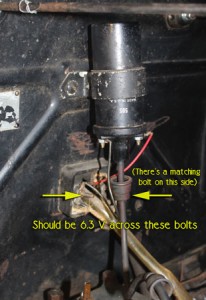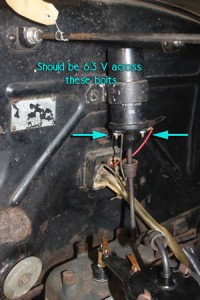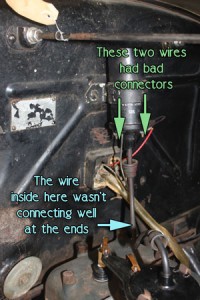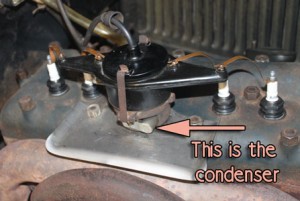But we don’t know why…
I had one of the guys, Dave, from the local Model A restorer’s club over on Friday to help with Daisy. At that point, I had already rebuilt the carburetor, and we were fairly sure she was getting gas. I had also drained the gas tank and put in some fresh, just in case the gas was bad. Dave and I had been emailing back and forth, and he had me check some voltages to see if the problem was electrical. I was able to get the voltages, and they seemed correct. And at this point Dave thought it was time for a visit.
Looking closely at the wiring in Daisy, I was becoming convinced that was likely the problem — it looked rather hinky. Despite having the voltages we thought I should have in all the right places, the state of the electrical made it suspect.
When Dave arrived, we started by re-measuring those voltages — as recommended by Les Andrews (Model A Ford mechanics Handbook).
Voltage across the junction box should be 6.3V (I don’t have a cover on my box — that will be included in my next order from Bratton’s). And it was.

Voltage across the coil should be 6.3 V…and it was.

The voltage across the points should also be 6.3V. I didn’t get a picture of that, but the voltage was right.
While checking those voltages, we discovered a few questionable wires. Dave pulled the one connecting the coil to the distributor. If it was a more-modern cable, it would have carbon inside instead of a wire, and that carbon can break down. Mine actually had a wire inside, and it had continuity. The connectors were a bit questionable, especially on one end where the wire wasn’t evident. Dave pulled that one, exposed a bit more of the wire and soldered back on the connector. I should replace this one soon, but it shouldn’t have caused the trouble starting.

Also, the wires going into the coil had sad connections — the black wire was connected to the connector with just a wisp of wire. He re-did that connection so that more wire was holding the connector.
None of this helped. Dave changed out my distributor cap with one that he had altered to have holes in the top so that you could see if there was spark. Daisy had no spark.
Next, we suspected the coil (I can’t remember why). So, Dave hooked up a coil that he had brought. Still no spark. He cleaned the tips where the spark should jump from the distributor’s rotor to ignite the plugs. Still no spark. We changed out my spark plugs, just in case. Still no spark. We changed out the condenser on my distributor for one that Dave had brought.
She still didn’t start right away. She did, however, backfire as I was pulling my foot off the starter. She had done that for me before, but I had another witness (besides Model A Husband). Dave confirmed that when that happened, there was a jump of a spark from the rotor to the nearest connector. He had no idea why. Nor could he figure out what it told us.
Dave turned to me and confessed that he was out of ideas. He sat down with the Les Andrews’ book, and doubled checked our check-list. Lucky me…I had stumped one of the experts. He had me try again and watch the amp meter that’s mounted in the car. If there was still a problem with the circuit, it should stay at zero. However, as I cranked the engine, it was bouncing around, so there were amps flowing.
Then, for some reason, we decided to try again. I can’t remember why. And I don’t think we tried anything else new. But…she started!!!
I hopped out to see the distributor spinning and sparks flying.
Since we weren’t sure what we had done that would cause her to finally start, we started pulling out Dave’s additions one-by-one. First we reconnected my coil. And she started. Then we replaced his peek-a-boo distributor cap with mine. And she started. And then we replaced his condenser with mine. And she started.
At this point, we just had the spark plugs left. Dave asks what we’re going to do if she still starts with my spark plugs. I laugh and say…be happy that she started? So, we put my spark plugs back in and…you guessed it…she started.
So, yay that she started. But…what is wrong? It is most likely electrical. And the problem is that it could go wrong again, maybe when I’m out on the road, and that wouldn’t be good.
At this point, I need to do a little work on the brakes before she’ll be safe to drive. But once I’ve done that, I’m going to take her out for short drives. Dave has suggested a few things for me to change out – electrical and not – so I’ll be working on those as well. But she’s alive!!


Recent Comments